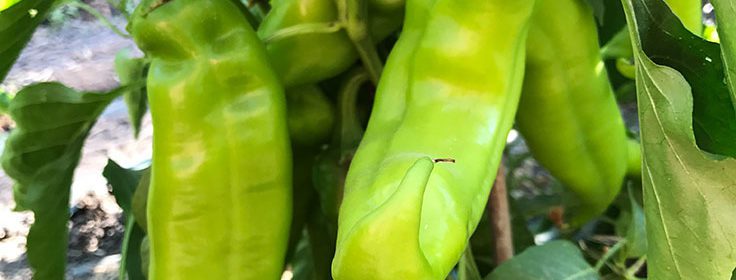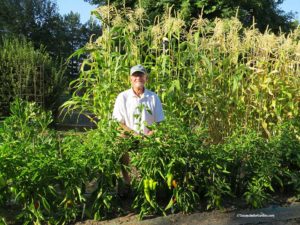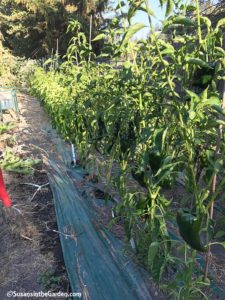Sept. 10 Column: Jim Gaddy on Growing Peppers

For today’s column, I had the pleasure of interviewing retired family practice doctor Jim Gaddy. He is an expert at growing peppers, so you’ll want to read his tips for success. Here’s a link to it: Doctor has just the prescription for growing peppers. (or you can read my column lower in this post)
In my column, Jim mentions IRT (infrared transmitting) mulch. This is a type of plastic mulch that he has found very helpful for growing peppers. If you are interested in learning more about it, here’s the University of Vermont’s Plastic Mulch Primer.
When I did a search on “IRT mulch,” I noticed that Territorial Seed and Fedco Seeds sell it, just in case you’re wondering.
While walking through Jim’s garden, I was very impressed with how productive his pepper plants are. He told me that no matter what happens during the growing season each year, and no matter how the other vegetable crops are faring, they always get a good crop of peppers.
Jim’s favorite peppers are the Hatch varieties because they like to make chile rellenos, Anaheim peppers and Italian sweet peppers. All of his pepper seeds come from The Pepper Gal, which is based in Ft. Lauderdale.
While we’re on the subject of growing vegetables, it’s time for the next installment of “Everyone Can Grow A Garden!” This will be the third in my series on pruning tomato plants so the tomatoes will ripen before the end of the season. Here it is:
Garden column: Jim Gaddy gardener profile
by Susan Mulvihill
The doctor is in — in the garden, that is.
Jim Gaddy may have retired as a family practice doctor three years ago, but his caregiving skills are still apparent in his vegetable garden.
“I’ve been gardening continuously for 42 years, ever since I moved to Spokane from Texas in 1975,” he explained. “When I bought my first house on the South Hill, it already had a garden. I decided I would give it a try and it worked out great.”
Twelve years ago, he and his wife, Meridith Molter [please note spelling of her first name is correct] bought 30 acres in southwest Spokane County. His wife doesn’t tend the garden but plays an important role nonetheless.
“Meridith and I have settled on a great division of labor,” Gaddy admitted. “I plant, cultivate and weed. And when I get tired, she swoops in and does the harvesting, freezing, and putting up of the vegetables. It’s a great relationship.”
While he enjoys growing tomatoes, melons, corn, squash and other crops, peppers are his favorite. That’s not surprising considering his Texas upbringing.
Prior to moving to his current home where he has a greenhouse, he would purchase pepper seedlings from local garden centers. A chance encounter in 1981 opened up a whole new world of options.
“I was on a plane flying to Texas for a week of fishing and saw a woman wearing a hat that said ‘The Pepper Gal’ on it,” he related. “Of course I had to go talk with her.”
It turned out she and her husband own the seed company, The Pepper Gal (peppergal.com) and were heading to a national pepper convention in Texas.
“She has seeds from over 300 varieties from all over the world,” Gaddy said. “So I started buying from her and have ever since.”
While touring his garden, I was impressed with the variety and vigor of his pepper plants.
Jim Gaddy shares his pepper-growing tips:
- “I start all my seeds indoors eight to 10 weeks before I’m going to plant, which allows me time to harden them off. My goal is to get them planted the third to fourth week of May.
- “I buy organic chicken manure to mix into the soil. I don’t use any chemicals or fertilizer in my garden but I do use lots of compost.
- “I’m a true believer in IRT (infrared transmitting mulch) mulch from the University of Vermont. It’s a cold-weather mulch that you lay out on your soil two weeks before planting. It has the advantages of black plastic — such as weed suppression — and gives me two weeks on the season.” (learn more at uvm.edu/vtvegandberry/factsheets/plasticprimer.html)
- “I use floating row covers over the plants early in the season. It’s like having a little greenhouse out there.
- “I’ve found the closer you plant peppers together, the better they do.
- “Drip irrigation works really well for growing them.
- “I stake my plants since they get top-heavy with peppers.”
This year, he grew Hatch (multiple varieties), Cubanelle, bells (Minibell, Chocolate Bell and Mexibell), Italian peppers, mole, ancho, jalepeno, and Fooled You (it has the appearance and taste of a jalepeno but not the heat).
When it comes to growing vegetables in the Inland Northwest, Jim Gaddy has learned an important point: “You can grow all the warm weather crops here but you have to be on the ball from day one,” he advised. “A week lost is a week lost in our short growing season.”


